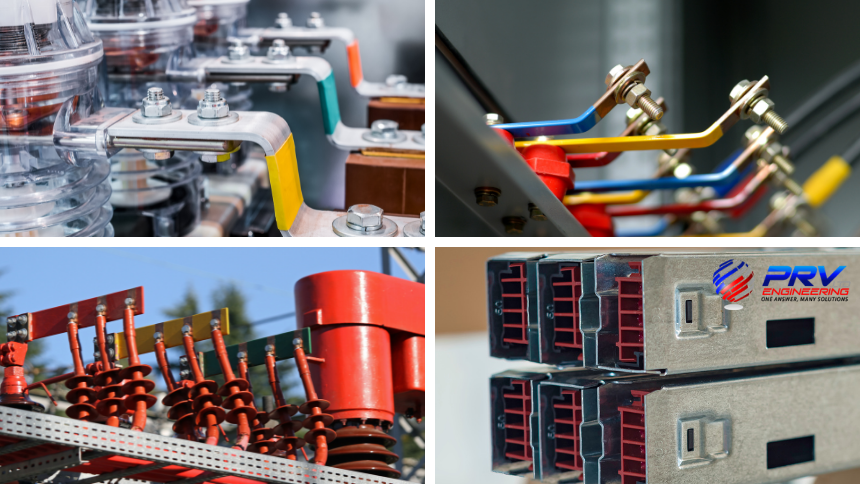
FAQ About Electrical Copper Busbars
First and foremost, busbars (often spelt bus bars or buss bars) are often metallic strips made from copper, brass or aluminium that ground and conduct electricity. Copper busbars are popular as the metal is soft, malleable and ductile with very high thermal and electrical conductivity. It’s the preferred choice for many due to its superb resilience to higher temperatures which provides extra security during short circuit situations.
How Do Busbars Work?
Busbars or “Busbar systems” refer to conductors that take the form of a bar or bars of copper which may be exposed or enclosed. The system can have one or more joints to ensure proper length and configuration with one or more take-off points connected to the intended piece of equipment.
Electrical copper busbars are conductors or groups of conductors that collect electric power from incoming feeders where they distribute the power to outgoing feeders. It’s effectively a type of electrical junction where all incoming and outgoing electrical currents meet.
The bus bar system has an isolator and circuit breaker which helps in the event of a fault. If a short circuit should occur, the circuit breaker trips and the faulty section of the busbar is easily disconnected from the circuit.
Recommended: ‘Why Are U-Shaped Busbars So Popular?’
Where Are Copper Busbars Used?
Busbars are used within electrical installations for distributing power from a supply point to several output circuits. They are often used in various configurations from vertical risers that carry current to every floor of big buildings to busbars within a distribution panel or an industrial process.
Copper busbars are used in electric power distribution, inside switchgear, panel boards, and busway enclosures for local high current power distribution. They can also connect high voltage equipment at electrical switchyards and low voltage equipment in battery banks, for example.
Busbars are incredibly versatile and can be found in factories, hospitals and educational institutions among many more. When a project has limited space and requires an alternative electrical distribution system, busbars are a perfect choice.
At PRV Engineering, our busbar services are of the highest quality as we work with customers in the power, rail, medical, marine, motorsport and aerospace industries.
Which Is Better, Copper Busbars Or Aluminium Busbars?
The proportions of copper enable higher currents to easily pass through the material and beat aluminium in electrical ratings. When compared by volume, it has lower electrical resistance, lower power loss, lower voltage drop and higher ampacity.
Due to the larger dimensions of aluminium bus bar systems, they may not be ideal in certain applications, including small buildings or under the floor. However, copper busbar designs can be made for nearly any application which makes it exceptionally versatile.
Copper is also more resilient to high temperatures and provides extra protection in the event of a short circuit. As copper is harder than aluminium, it provides better resistance to damage that may occur during installation and when in service.
The only disadvantage of copper is its higher density which often requires more manpower during installation. The higher density should also be considered if a system has specific weight requirements.
What Is Busbar Trunking?
Busbar Trunking is a system of distributing electric power using copper or aluminium busbars with suitable enclosures. It offers good protection to cables preventing them from getting damaged due to foreign bodies. Busbar Trunking is also much better at cooling the system than using traditional cables.
Busbar Trunking systems greatly reduce the time it takes to install and maintain thanks to a fast joining feature that enables you to put it together in no time at all. As there is no need for hard-wiring, Busbar Trunking systems also reduce installation and maintenance costs.
An added benefit is that you can buy individual busbars which helps when it comes to calculating costs depending on the number of copper busbars you might need.
What Are The Benefits Of Using Busbars?
Busbars are becoming irreplaceable due to the convenience and safety factors. There are countless benefits of using busbars but we’ve highlighted the most impactful ones below.
- Due to the compact design, copper busbars require less space than traditional cabling systems
- Although more expensive than a wiring harness, busbar systems will last longer and don’t require frequent replacement
- Copper busbars distribute power more efficiently and can be easily adapted for renewable energy integration
- Due to its exceptional conductive properties, copper busbars are great for distributing electricity As it’s a stronger metal, it has good protection against damage from high temperatures which increases the busbar life-span
- Copper busbars are more flexible than cables and can be used in nearly any kind of structure with various configurations
- Busbars are super versatile so they can easily be relocated without spending a fortune
Conclusion
As energy is expensive, we take all of these considerations into account at the design stage of our busbar services. Certain measures are taken to increase energy efficiency within your system which will make your system far more cost-effective. Our team of experts can also advise you on the right options every step of the way.
PRV’s copper busbars offer the perfect balance between cost and application, especially on projects that require high performance, versatility and reliability. As part of our busbar manufacturing services, we provide a range of specialist coatings that offer additional insulative or conductive properties.
We specialise in the use of copper to manufacture all components for low, medium and high voltage Industries. This includes rail rolling stock and trackside electrical components. For more information on our copper busbars and other specialist engineering services, visit the PRV Engineering website or read our blog.


 Mail:
Mail: 




